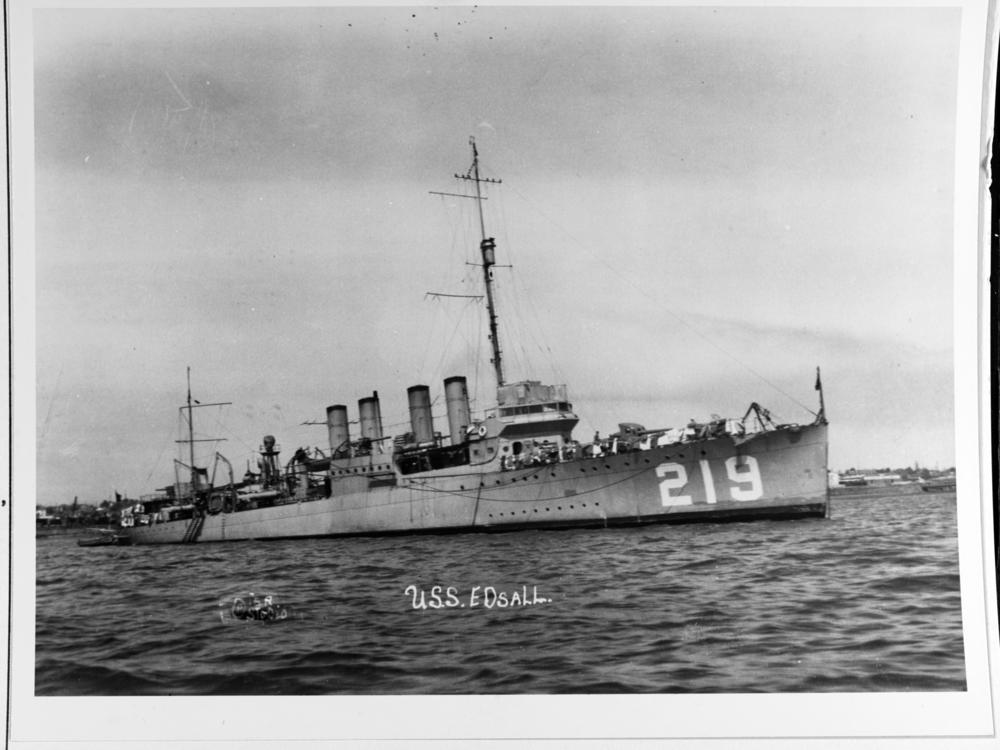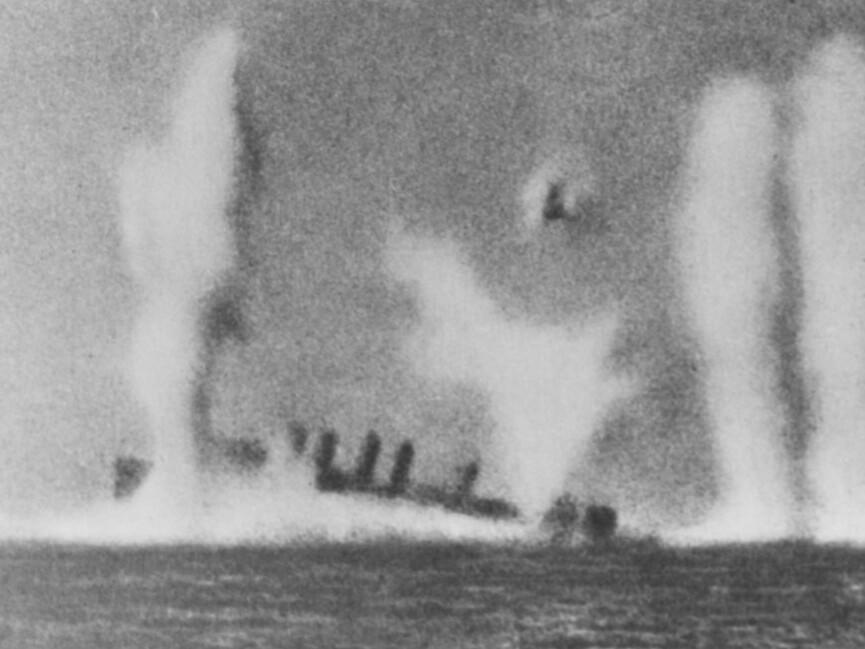Section Branding
Header Content
The USS Edsall, sunk by Japanese forces in World War II, has been found
Primary Content
The USS Edsall, an American warship known for its crew's courageous last stand against Japanese forces during World War II, has been found.
The U.S. Navy announced the discovery on Monday. The 314-foot destroyer was found by an Australian survey ship last year, deep in waters south of Australia's Christmas Island. But it wasn't positively identified as the Edsall until last week.
The ship was surprised by Japanese battleships on March 1, 1942, in the Indian Ocean. It was outgunned and already reeling from damage sustained weeks earlier, and had been deemed not fit for combat duty. There were 185 U.S. Navy personnel and 31 U.S. Army Air Force pilots aboard at the time, the Navy said.
The crew "lost in a valiant battle against the Imperial Japanese Navy in the early days of World War II. The commanding officer of Edsall lived up to the U.S. Navy tenet, 'Don't give up the ship,' even when faced with overwhelming odds," Chief of Naval Operations Adm. Lisa Franchetti said in a statement.
First launched in 1920, the Edsall played a role in sinking Japan's I-124 submarine, which became one of the first Japanese subs lost in World War II. On March 1, 1942, the Edsall was likely responding to a distress call of another American ship when Japanese forces spotted it about 225 miles south-southeast of Christmas Island. It "fought a hopeless action against an overwhelming force" of two Japanese battleships and two heavy cruisers, the Naval History and Heritage Command says.
Japanese forces fired more than 1,300 shells at the Edsall. The Edsall's commanding officer, Lt. Joshua J. Nix, fired back, but he faced superior firepower.
The Edsall produced a wall of smoke to hide its position and engaged in evasive maneuvers, frequently changing its speed and direction. "According to a Japanese observer, Edsall performed like a 'Japanese dancing mouse' (a popular domesticated pet in Japan, also known as 'waltzing mice' or 'whirler' for its manic and bizarre movements). If it were not for the unpredictable speed and course changes, the Japanese would have put Edsall under a lot sooner," writes Samuel J. Cox, director of the Naval History and Heritage Command, in a history.
Then the Japanese commander, Vice Adm. Chūichi Nagumo — who had led the attack on Pearl Harbor a few months earlier — launched dive bombers to pound the Edsall. Nix positioned the Edsall with its bow facing the Japanese ships, in what is considered a symbol of defiance. An hour and a half after being spotted, the Edsall was "dead in the water," Cox writes. It capsized and sank soon after.
A handful of survivors were taken aboard by Japanese forces, while others were left in the water to die. But those who were taken prisoner fared no better: None of the Edsall's crew or passengers survived the war, according to the Navy's history. Mass graves later found in Indonesia showed prisoners were decapitated.
The ship was found last year by the Australian navy
The Royal Australian Navy's MV Stoker located the Edsall late last summer during a hydrographic survey, an NHHC spokesperson said. The wreck is sitting at a depth of more than 18,000 feet. The Australian navy notified the NHHC in May of this year, but the agency's experts first had to determine it was not another American ship, the USS Pillsbury, that had been sunk a day later in a battle with Japanese forces.
However, the "damage evident on the wreck site" and its location is more consistent with the Edsall, a spokesperson said, and the U.S. Navy determined on Nov. 6 that "the preponderance of evidence leads to the identification of the wreck as the remains of Edsall."
Chief of Naval Operations Franchetti called the wreck a "hallowed site" for the roughly 200 people who died there. The discovery was also announced by Caroline Kennedy, U.S. Ambassador to Australia, who said in a statement: "We will now be able to preserve this important memorial and hope that the families of the heroes who died there will know their loved ones rest in peace. We will tell their stories, learn from their bravery, and be inspired by their sacrifice. We will always remember them."
"Because there were no living U.S. witnesses to Edsall's last fight, there are no Medals of Honor, Navy Crosses or Presidential Unit Citations for what was one of the most gallant and valorous actions in the history of the U.S. Navy," Cox wrote. "Nevertheless, we have a duty to remember their courage in the face of overwhelming odds."


